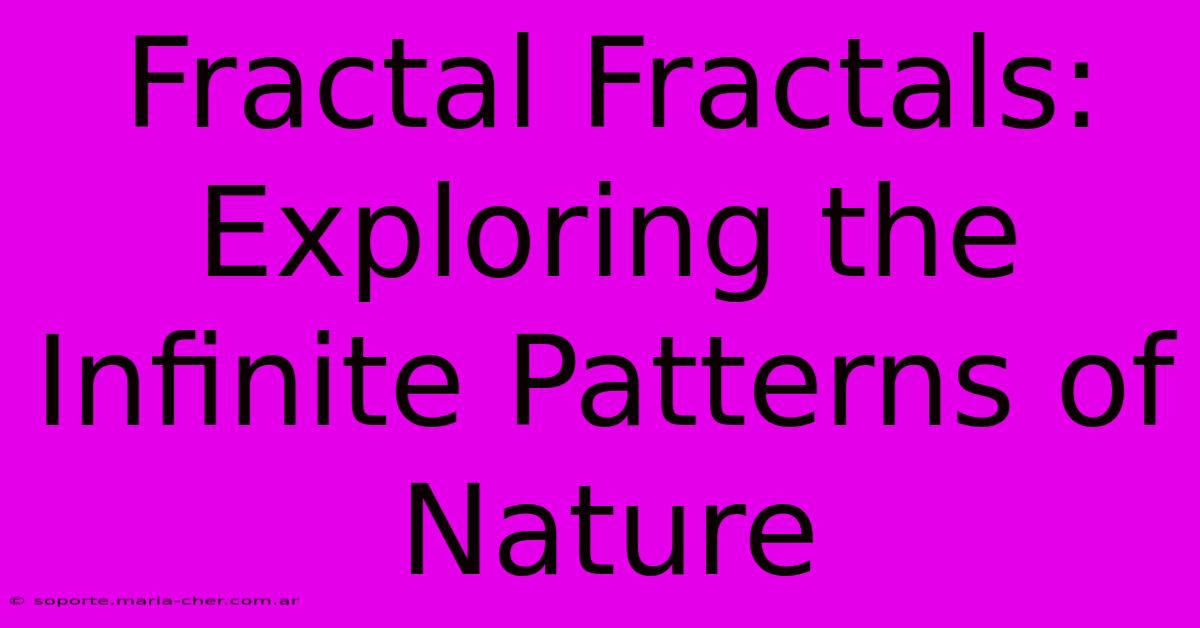Fractal Fractals: Exploring The Infinite Patterns Of Nature

Table of Contents
Fractal Fractals: Exploring the Infinite Patterns of Nature
The world around us is full of intricate designs, repeating patterns that unfold at different scales. From the branching of a tree to the swirling arms of a galaxy, these mesmerizing structures are often described as fractals. But what exactly are fractals, and why are they so prevalent in nature? Let's delve into the fascinating world of fractal geometry and uncover the infinite patterns hidden within our natural surroundings.
What are Fractals?
Fractals are complex geometrical shapes characterized by self-similarity. This means that their patterns repeat at different scales – zooming in on a portion reveals a smaller version of the whole structure. This self-similarity isn't perfect; it's often approximate, but the overall pattern persists. Think of a fern: each leaflet looks like a miniature version of the entire fern, and each sub-leaflet mirrors this pattern again. This recursive structure is a hallmark of fractals.
Key Characteristics of Fractals:
- Self-similarity: The most defining characteristic. Parts of the fractal resemble the whole.
- Infinite detail: No matter how much you zoom in, you'll continue to see intricate details.
- Non-integer dimension: Fractals don't fit neatly into our typical understanding of dimensions (1D, 2D, 3D). Their dimension is often a fraction, hence the term "fractal dimension."
- Iterative construction: They are often created through iterative processes, where a simple rule is repeated many times to generate complex patterns.
Fractals in Nature: Examples Abound
Fractals aren't just mathematical curiosities; they're ubiquitous in the natural world. Here are some stunning examples:
1. Trees and Plants:
The branching patterns of trees, the veins in leaves, and the intricate structures of flowers are all classic examples of fractal geometry. Each branch subdivides into smaller branches, creating a self-similar structure that maximizes sunlight capture and nutrient distribution.
2. Coastlines:
Coastlines are famously fractal. The closer you look, the more intricate the details become, revealing bays, inlets, and headlands. Their length is also scale-dependent; the more precisely you measure, the longer the coastline appears.
3. Mountains and Rivers:
The rugged contours of mountain ranges, the meandering paths of rivers, and the branching networks of river systems exhibit fractal characteristics. These patterns are a result of complex geological and hydrological processes.
4. Clouds and Lightning:
The wispy shapes of clouds and the branching patterns of lightning bolts are also fractal in nature. The unpredictable, chaotic processes that create these phenomena result in self-similar structures at different scales.
5. Animal Structures:
Even within animal biology, fractals play a role. For instance, the intricate branching of blood vessels and the patterns on some animal skins display fractal characteristics.
The Significance of Fractal Geometry
Understanding fractals is crucial for numerous scientific disciplines:
- Ecology: Modeling the growth and distribution of plants and animals.
- Geography: Analyzing the complexity of landscapes and coastlines.
- Physics: Studying turbulence, chaos, and other complex systems.
- Computer Graphics: Generating realistic natural-looking textures and landscapes.
- Medicine: Analyzing the structure of blood vessels and organs.
Conclusion: The Beauty of Infinite Patterns
The prevalence of fractals in nature highlights the underlying order and efficiency of natural processes. Their infinite detail and self-similarity are not only aesthetically pleasing but also provide valuable insights into the workings of the natural world. By exploring fractal geometry, we gain a deeper appreciation for the beauty and complexity of our planet and the universe beyond. Further research into this fascinating field continues to uncover new applications and reveals the profound impact of these infinite patterns on our lives and understanding of the world.

Thank you for visiting our website wich cover about Fractal Fractals: Exploring The Infinite Patterns Of Nature. We hope the information provided has been useful to you. Feel free to contact us if you have any questions or need further assistance. See you next time and dont miss to bookmark.
Featured Posts
-
Emerald Enticements Explore The Enigmatic Charm Of Green Roses
Feb 08, 2025
-
Polaroid Picture Perfect Dimensions Revealed For Your Nostalgic Memories
Feb 08, 2025
-
Unveil The Enchanting Secret Lily Of The Valley Bouquet Unveiled
Feb 08, 2025
-
Maximize Your Decor With The Enchanting Power Of Bulk Dried Babys Breath Create Unforgettable Moments
Feb 08, 2025
-
Unlocking The Elegance Of Affordable Flower Centerpieces
Feb 08, 2025
